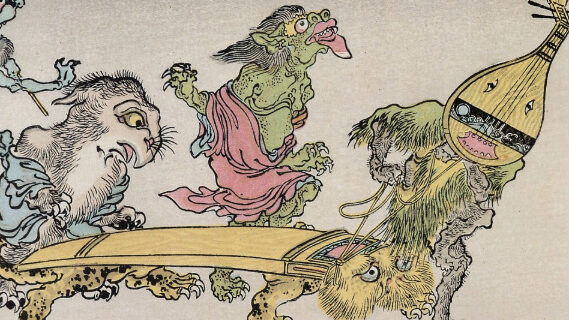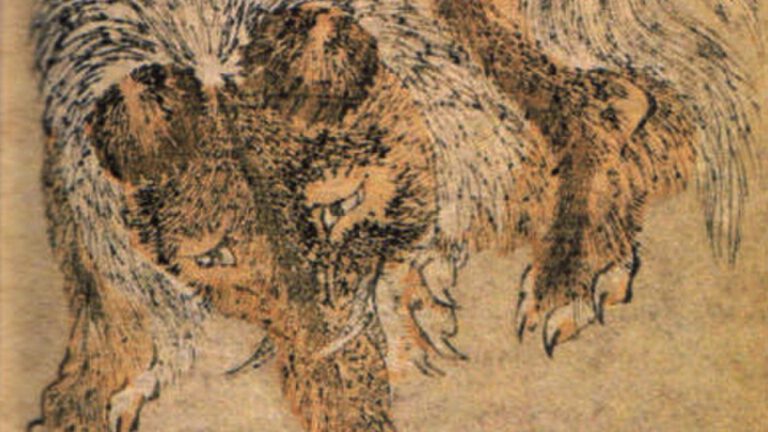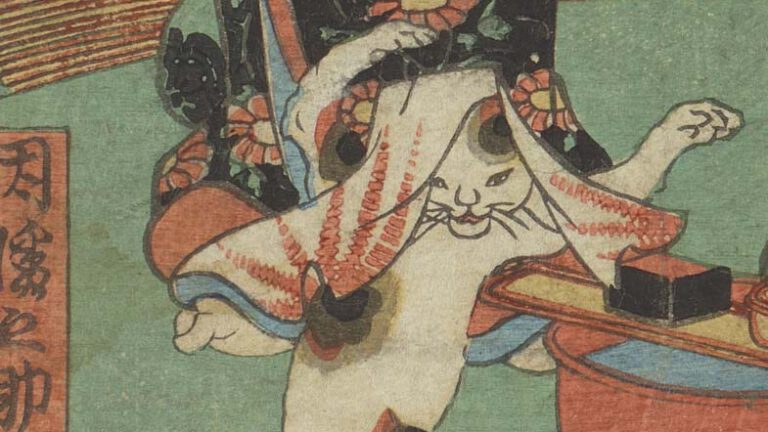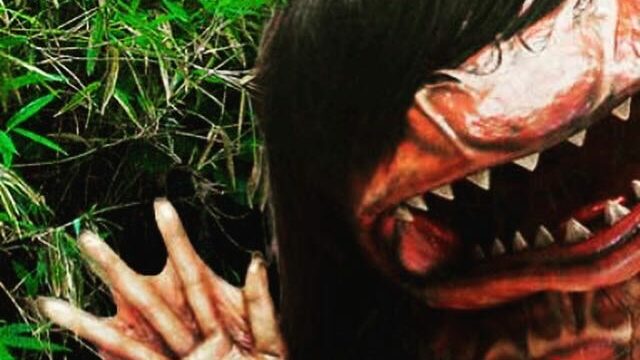The Sickle Weasel – Kamaitachi / 鎌鼬
This is Thersa Matsuura and you’re listening to Uncanny Japan.
The Kamaitachi/Sickle Weasel
What do you know about the yōkai, the sickle weasel or kamaitachi? Imagine an adorable little weasel sporting obnoxiously long blades on its paws. It appears out of nowhere so suddenly you don’t even realize its attacked you, until later when you notice you’ve got a deep cut that strangely isn’t bleeding and doesn’t hurt.
Today, let’s talk about this furry little madman and a few other related creatures, as well as a straight up, non ironic conversation I had with my friend about the kamaitachi.
Intro:
Hey hey, how is everyone holding up? I hope you’re all fine and well and finding something weird and wonderful to hang onto or escape to in this whacked out age we’re living in.
Before we get into the weird and wonderful sickle weasel, let me give you a bonus weird and wonderful bit of news.
Update on Ashiarai Yashiki!
Remember the Ashiarai Yashiki? The legend of an enormous, dirty, hairy leg busting its way into some poor person’s home and demanding to be washed? If the order isn’t met, it just goes stomping about the place, ruining everything. But if it is washed, then the offending limb just disappears back through the hole in the ceiling as if it hadn’t even been there.
And remember our buddy John who I talked about on Episode 102, who said he had heard a curiously similar story from his father but, hey, they live in the States, not Japan. The southern States to be exact. He was wondering if I or anyone had ever heard of a similar story and I made a little plea to listeners at the time.
Well, guess what! I got some information. Shiny new and very cool Patron, Caitlin, messaged me and said that her grandmother used to tell her a story when she was little that rang some bells. Caitlin’s grandmother is from Gorgas, Alabama, so we are in the right area. The tale went something like this. A little girl digging around in the garden comes across a giant potato. Her and her grandmother carry it to the house to cook, but as they start cooking it, a giant foot comes bursting through the roof demanding to know where its big toe is. It’s a little different, but definitely close.
Thank you, Caitlin for sharing your story and memory and thank you John for asking.
After monkey pox, does anyone have giant feet stomping through homes across the globe on their bingo card? If not, pencil it in.
Okay, let’s get to today’s show.
What is the Kamaitachi Attack?
Have you ever cut yourself and have no memory of where or how it happened? I’m not just talking about any cut, not a scrape or light cut, but a fairly deep one that doesn’t bleed or bleeds just a little and there’s no pain. Well then, congratulations, you were just attacked by a kamaitachi / 鎌鼬 or sickle weasel.

What Does it Mean?
The characters are straight forward, kama / 鎌 means sickle and itachi / 鼬 is a weasel. The old images you can find from let’s say Toriyama Sekien as well as other artists usually depict it as being just as adorable as you’re imagining now. A long furry weasel, a blade in each paw, riding on a dust devil.
Speaking of Toriyama Sekien. He’s the first one to portray this yokai as a bladed weasel and it sounds like the characters he used and his drawing are a pun on the characters: kamae tachi / 構え太刀 which is translated as “sword stance”, but needs some explanation. Kamae / 構え means “getting ready for a fight”, like getting into your fighting stance. My son took karate for many years and before sparring the teacher would yell Kamae! So that gives you and example of its meaning.
Tachi / 太刀 on the other hand, is a sword, different than a katana. It was actually invented first, has a more pronounced curvature, and was worn with the blade facing down, where a katana faces up. So anyway, there are some who thought that mysterious wound looked like one you’d get from someone slicing at you with a tachi, so it was called kamae tachi. And then silly and brilliant Toriyama Sekien comes a long and turns it into kamaitachi. Sickle Weasel. At least that’s one explanation and my favorite.
I read in another place in Japanese that the “kama” wasn’t “sickle” but “kaze no ma”, “between the wind”. Maybe because a gust of wind blows in and you get sliced in an instant, between the wind. I don’t know. Something like that. But I like it.
Or, here’s another idea that was written about in Edo Era texts. There is a Chinese mythical creature called a kyuuki / 窮奇 different characters and different creature entirely. It looks more like a tiger with wings. But it also used wind as a means of transportation. If you read those characters using kun yomi (the Japanese pronunciation) instead of on yomi (the Chinese pronunciation) then you get kamaitachi, evidently. And from there it became a weasel with knife-like claws. Don’t ask me. Just know that Toriyama Sekien drew the little guy in 1776 and he was a big hit.
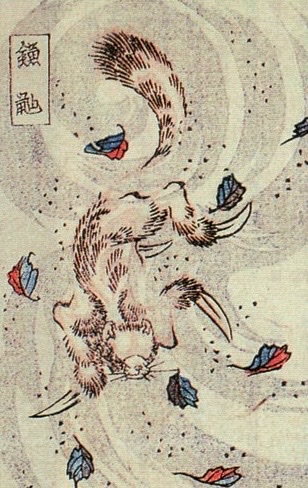
My True Story with Friends
Here’s a true story: The first and only time I ever heard the kamaitachi discussed in regular conversation was when I was having lunch with two friends a couple years before The Virus. One was talking about a little known park up in the mountains and how she wanted to take her children there to play. The other friend said, she’d been there before and while it was quite nice, you should be careful of the kamaitachi. One of her kids had been attacked by one.
That first friend and I exchanged a glance and widened our eyes. Now that’s a statement you don’t hear everyday. Something like, “Yeah, I’ve been to that restaurant in that alley before. It’s good, but be careful of vampires, my husband was bitten by one last month.”
Be careful of the kamaitachi? We had to ask for more details about what she meant. She went on to explain that one of her children, while playing there, had suffered cuts on their legs that were totally unexplainable. She also said the place was well known for that happening. And she said all of this with a straight face.
Both the Yōkai and the Condition
This is when I learned: that the word kamaitachi can be used to refer to the yōkai itself and the condition of getting a deep, non bleeding, non painful, unexplainable cut. Keep that in mind for later.
So where does this creature live and where does this freaky condition usually happen? It sounds like they are mostly found in the prefectures of Yamanashi, Nagano, and Niigata, the middle of Japan. But in genreal, colder regions. But then the more I read, the more I find tales of them or similar yokai from all over the place. But encounters are more prevalent in cold snowy regions, though. That’ll be important in a minute.
A Typical Attack
So what happens exactly? Here’s a typical example of a kamaitachi attack. It’s a little contradictory. You’re out minding your own business when the wind kicks up, perhaps a dust devil blows through. Or, sometimes nothing at all happens. It’s just a nice day. You could be knocked down, or not. It could be like nothing happened at all. It’s thought that the kamaitachi is so fast you can’t see it, or some believe it’s just invisible. Sometime later you discover a cut or cuts on your skin. Usually your calves and thighs. It doesn’t hurt and there is no to very little bleeding. But then there are some sources that say it doesn’t hurt at first but excruciating pain follows later. As for bleeding, one Japanese site theorized the little weasels suck your blood.
What to do? Why does it Happen?
In the Nagano and Niigata regions it’s believed they are actually three evil weasel gods, akugami. The first one knocks you down, the second one cuts you with a blade, and the third one applies magical ointment to the wound so it doesn’t bleed and doesn’t hurt.
But don’t ask why, because I couldn’t find any real reason why this happens except being in the wrong place at the wrong time. But if it does what can you do? Well, after you’ve been attacked and if you happen to live in the Tohoku Region you can burn an old calendar and rub the ashes all over the wound. Then it will heal.
Air Pressure?
Now, there’s something I saw written about a lot and I also got from my friend when she was explaining her run in with the knife weilding creatures, and that is that some believe the condition to be caused by a change of air pressure. That a sudden change in the barometric pressure brought along by a whirlwind and cold would cause the more plump parts of your body to kind of burst open, a little bit. Which is not only horrifying, but also, not how the body works, I don’t think.
Shizuoka – The Akuzenshi no Kaze
I was surprised to find there’s actually a lot written about these furry fellows, and while I can’t fact check everything, even if that was possible. But there was one tiny mistake I kept seeing repeated that I’d like to clear up. Especially because it relates to Shizuoka Prefecture my home base for the past three decades, and the original is more interesting than the mistranslations.
So it looks like there is a similar phenomena in the Shizuoka or Suruga area called an akuzenshi no kaze (not akuzen kaze). This yokai might have the best name ever. Aku mean bad or evil, zen shi is a Zen master or teacher and of course kaze would be wind. So hilariously you could translate this as The Evil Zen Master’s Wind.
I poked around though and found one site that stated — much like in the Toryiyanse episode when we learned perhaps kowai-scary just meant tired back in the day. This place said that aku-bad or evil probably just meant wild or rowdy. But, hey, the Wild and Rowdy Zen Teacher’s Wind is just as funny. So I’ll take either one.
This Shizouka version of the kamaitachi is thought to resemble something called an ichi moku ren 一目連 / which comes from Mie Prefecture originally. An ichimokuren is a wild wind that blow through and let’s say destroys a house, but leaves everything around it intact. There’s even a shrine dedicated to it in Ise Prefecture.
But back to the Evil Zen Master’s Wind, the akuzenshi no kaze. What does it look like? Well, local folklore says it resembles a person wearing a brown hakama (those cool billowy pants). So, you’re telling me it could be ANYone? But it’s not anyone, it’s a god in disguise and it can kick up some pretty gusty and dangerous wind if it wants to. Not much else.
A Doctor’s Blog
Okay, I’ll end with a blog I found by a Japanese medical doctor who addressed the kamaitachi on his site.
He talks about how people come in with complaints of this kamaitachi (the cuts) and he wants to get down to what might have caused them. Again, they are sudden unexplainable deep cuts usually on your meaty bits (his words, my translation), like calf or thigh. He goes on to say that very often they happen on a part of your body that’s been covered up. You’re wearing pants. Which adds to the mystery and rules out a theory he has, but I’ll get to that in a minute. The doctor also says left alone these wounds will heal in about a week.
He gives four of the most common theories:
1. Barometric pressure change. The one I mentioned early. Nope, he says. No way. That’s ridiculous, it doesn’t work that way. That’s what I said!
2. Temperature change. Because kamaitachi usually occurs more in cold areas, some think it’s like when you heat up glass and then cool it quickly. The glass cracks, so why not your skin? This doctor said of all the theories this one was the most promising.
3. The Small Stone theory. He said this idea has been gaining traction recently. Your cold and some gusty wind blows in and happens to be carrying small stones with it. Then they slice your skin. But this theory goes out the window if you’re wearing pants.
And 4. It’s a yōkai. To the doctor’s credit he added a little Lol at the end of that one.
His conclusion was that there are things that happen to the body that still can’t be explained by science yet. So there’s that.
All-righty then, I’ll let you go for now, stay well, and we’ll talk again real soon, bye bye!

